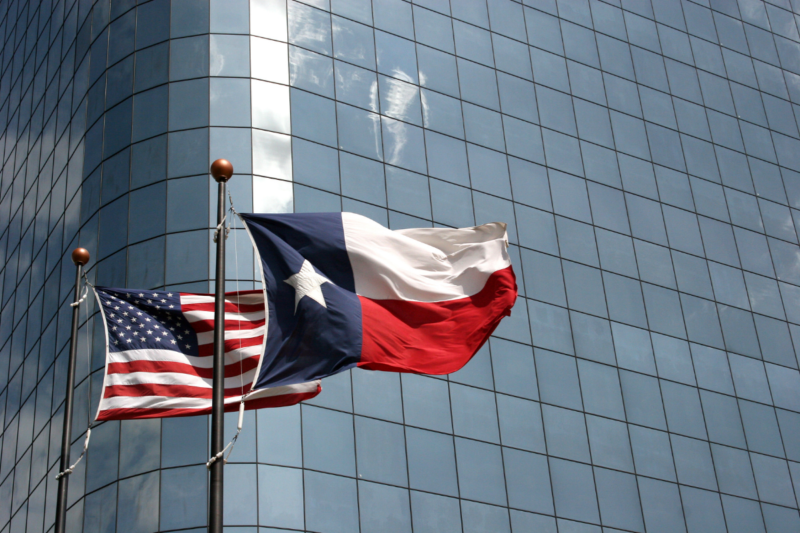The Consumer Price Index in the Dallas-Fort Worth-Arlington area rose 7.5% from a year ago in November, compared to a national increase of 6.8%, according to data released Friday.
Texas inflation, as measured by that indicator, has run hotter than the U.S. inflation rate all year. Inflation rates can vary by region based on differing rates of growth, unemployment, supply-chain issues, and other factors.
Factors uniquely affecting inflation in Texas include the faster lifting of pandemic restrictions, a tighter labor market, surging rents, and rapid population growth.
However, national factors such as central bank policy and federal spending affect the inflation rate in all parts of the country. The Consumer Price Index (CPI) measures the percentage change in prices of food, clothing, shelter, fuel, airplane tickets, drugs, and other goods and services.
The Bureau of Labor Statistics (BLS) doesn’t track a statewide inflation rate but it monitors prices every two months in the Houston-Woodlands-Sugar Land area and Dallas-Fort-Worth Arlington, alternating its surveys between these two each month.
The Houston rate has run somewhat cooler than the Dallas rate. The last reading for October came in at 6.1%, nearly the same as the national CPI rate in that month, 6.2%. Unemployment in Houston is higher than the rest of the state, which could be weighing on pricing in the city.
Nationally, the Consumer Price Index rose 0.8% in December, a notch higher than economists had predicted, according to a consensus forecast of 0.7% in a Dow Jones survey. That makes for a change of 6.8% from a year ago, the highest inflation since 1982.
Dallas area inflation (7.5%) was the fourth highest of any metropolitan area in the country, behind Tampa-St. Petersburg-Clearwater (8%), Atlanta-Sandy Springs-Roswell (7.9%), and Riverside-San Bernardino-Ontario (7.9%), and tied with St. Louis.
The CPI rate in the North Texas region had previously peaked at 6.3% in May, at a time when the national CPI was only 5%. Prices then rose somewhat more moderately through the summer and spring, at 5.6% in July to 5.9% in September, before the late-year spike.
Inflation throughout the American South was 7.2%, according to the BLS, compared to 6% in the Northeast, 6.1% in the Pacific, 7.3% in the Midwest, and 7.7% in the Mountain region.
Eye on Housing
Moody’s Analytics, which accurately forecast that the CPI print would come in at 0.8%, hotter than the consensus forecast, wrote in a briefing earlier this week that rising energy costs, higher car prices, and higher rents were key drivers of the inflation spike.
A fall in oil prices since early November could alleviate inflation going forward, but that relief came too late for the latest CPI reading. “Though energy prices have dropped, this change will be captured more in December’s CPI, rather than November’s,” Moody’s noted.
Moody’s Senior Director of Economic Research Ryan Sweet, the lead author of the brief, also forecast that housing costs could continue to increase next year: “Rental inflation will be a bigger issue for inflation next year—it could offset some of the disinflation pressures from the improvement in global supply chains.”
Previously, economists at the Federal Reserve Bank of Dallas forecast that inflation associated with housing costs will “accelerate in years to come,” reaching a rate of 6.9% by year-end 2023, without showing any signs of leveling off.
‘Worrisome Parallels with the Early 70s’
The Federal Reserve, which controls the U.S. money supply, has continued a program of monetary expansion and ultra-low interest rates even in the face of mounting inflation.
Some observers that the Fed will be able to control the inflation by raising interest rates next year and into 2023, which could bring about a return to the low-inflation, low-growth environment of the 2010s, in the aftermath of the 2008 financial crisis.
But others believe the central bank is acting too slowly. “The Fed is reactive, not proactive, and that worries me,” said Economist Stephen Roach, a Senior Fellow at Yale, on a program aired on CNBC yesterday. “We’ve got clearly a much more serious inflation problem than they anticipated.”
“They’ve attempted to sort of cover themselves and abandon this notion of ‘transitory,’ short-lived increases, but that (still) leaves the real federal funds rate… deeply in negative territory.”
Roach went on to refer to the “horrible mistake” made by then-Federal Reserve Chairman Arthur Burns in the early 1970s by keeping real interest rates in deep negative territory, ”sowing the seeds of the Great Inflation.”
“No one thinks that’s going to happen this time—I don’t either—but there are some worrisome parallels with Fed denial in the early 70s,” he said.
